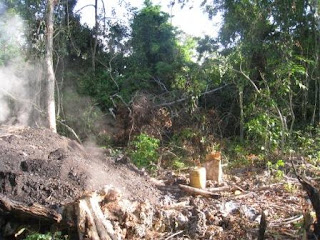Charcoal Burning
If you cast your eyes back through the many blogs we've posted about our coastal forest research you'll see plenty of references to charcoal burning; we're talking here about the production of charcoal using pit kilns. So our forest officer Matt has come up with the facts and figures to help explain quite why it is such a wasteful use of the forest resources...
About 47% of Kenyan households use charcoal and total annual production in Kenya is about 2.4 million tonnes (over 67 million bags weighing 36kg each). This preference is explained by its affordability; it is the cheapest form of household cooking fuel (Kwale Management Team, 2009).
In Shimoni and surrounding areas the majority of charcoal production is for subsistence purposes and therefore on a relatively small scale, however their methods are basic and highly inefficient, using an earth-mound kiln. This begins with digging a shallow pit, which can be from 4 sq. metres to 25 sq. metres from what we've seen in Shimoni.

Trees are then felled, cut in to small pieces, and piled in the bottom of the pit. A wall is constructed around the pit using rock tightly packed down with earth. An earth roof is constructed to seal the structure and starve the combustion process of oxygen with a few small holes to allow the smoke to escape. Fuel poured over the wood helps to light the pile when ready, with grass stuffed through holes in the wall and roof lit, to ignite the wood inside.

It is usually the old mature hardwood trees that are felled for this process, and a relatively small portion of the tree itself will actually end up in the kiln. Around just 10% of the wood that does go in to the kiln will actually come out as usuable charcoal. And of the charcoal that does come out, 80% of the enrgy from the wood has already been lost in the combustion procees to turn it in to charcoal. The rest of the tree, its wood and energy, goes to waste.













0 comments:
Post a Comment